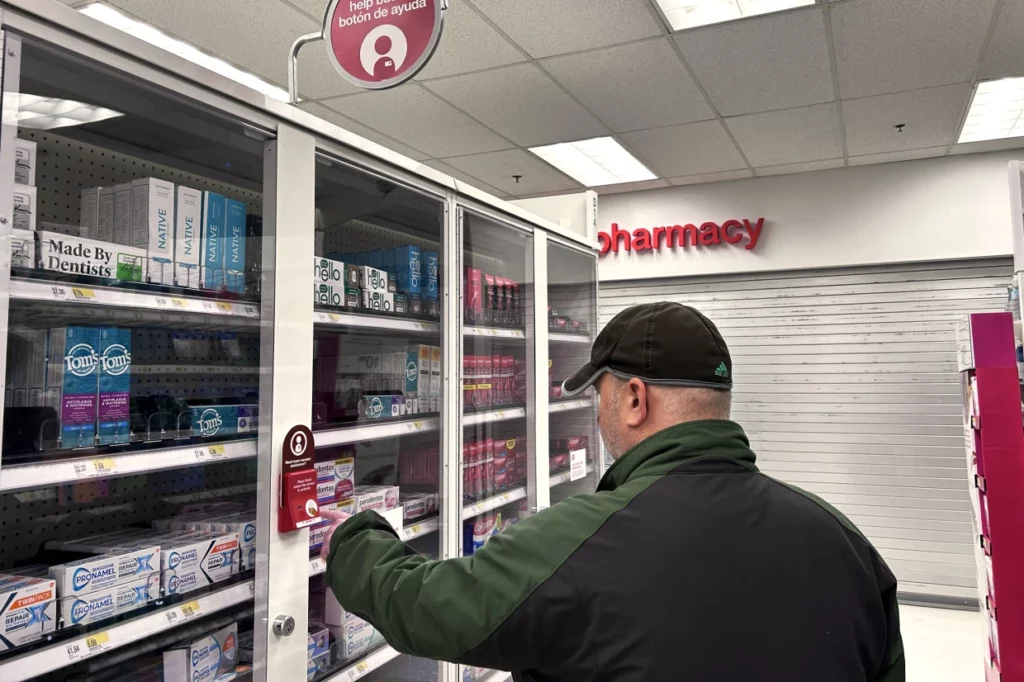Shoplifting is beginning to seem like an epidemic to Americans.
It’s growing in popularity and feeding concerns about crime and the future of big cities. For example, New York City is experimenting with new approaches to deal with shoplifting, given that reports of theft from retailers reportedly rose by 77% between 2017 and 2022.
Former President Donald Trump appears to view those fears as a political advantage as evidenced by his October remarks that he would back shooting shoplifters.
Some retailers have explained that they are being forced to close some stores and lock up merchandise elsewhere due to an outbreak of shoplifting, particularly “organized retail theft,” where goods are stolen in bulk and resold online.
Growing Anxiety
More than in all of 2022, a group of large retailers mentioned shoplifting 31 times in their earnings calls during the first half of 2023.
The vice president of asset protection and retail operations for the National Retail Federation, located in Washington, D.C., David Johnston, wrote in September that “we are living in a nation where stealing is no longer considered a crime, and those who steal are not criminals.”
It’s challenging to determine whether shoplifting has actually increased nationally despite all of the extreme claims. The difference between theft from retailers and other types of robbery is frequently overlooked by law enforcement.
However, larceny as a whole is less common than it was prior to the pandemic. According to the nonpartisan think tank Council on Criminal Justice, there was a 7% decrease in theft during the first half of 2023 when compared to the same period in 2019.
The US ranking of retail theft.
Retailers refer to this type of inventory loss as “shrink,” and analysts Dylan Carden and Phillip Blee of William Blair & Co. say that nationwide, theft and other types of inventory loss appear to be just getting back to normal after falling to abnormally low levels in 2020 and 2021 due to the pandemic.
However, local conditions can differ greatly from the national average, and the NRF has confirmed that its members are in fact reporting higher rates of theft. It has dedicated the last few years, along with other retailer groups, to the specific issue of organized retail theft.
The organization cites member surveys as evidence that theft is on the rise. The survey data indicates that overall theft has increased more gradually than the NRF is claiming, despite the fact that it is difficult to verify.
Nevertheless, as a result of its lobbying efforts, a federal law requiring online sales platforms to gather and reveal the identities of some sellers was passed. This is an attempt to discourage the online sale of stolen goods. Similar laws have been passed by a few states.
Currently, the NRF and other organizations are supporting a new bill that would make it simpler to file federal theft charges and impose harsher sentences for theft. Retailers claim that will discourage thieves, but opponents claim it’s reminiscent of the government’s harsh enforcement of anti-illegal drug policies in the 1970s, which resulted in mass incarceration.
Journalists have noted that some of the stores that corporations such as Target are closing don’t appear to be the ones that have had the highest rate of shoplifting. However, not all shoplifting is reported, and there may be complicated consequences if theft increases.
Underperforming stores and insufficient labor
Greater shrinkage could also be caused by other factors. First off, staffing levels in stores have generally decreased, which may lead to an increase in theft opportunities. Additionally, they dissuade staff members from intervening when they witness theft.
Additionally, self-checkout kiosks are becoming more and more common. This presents a chance for theft or could cause law-abiding customers to give up on a broken scanner and leave the store.
Carden and Blee report that there appears to have been a slight increase in shoplifting, particularly “organized” theft of goods that are subsequently sold online. They also concur that there might not be many options for retailers. Even though it costs them sales when customers decide to shop somewhere else or give up trying to find an employee to retrieve the items they need, many of them still choose to lock up merchandise.
Despite this, they claim there are signs that businesses are exaggerating the issue and, in certain situations, are doing so to divert attention from their own errors.
Carden and Blee noted in an October report that although theft is “likely elevated,” retailers may be using that to deflect attention from more recent internal issues that have negatively impacted their businesses, such as inventory issues or an excessive reliance on price reductions to increase sales.
“We also think that certain more recent shrink-related permanent store closures are related to these locations’ underperformance,” they stated.
Even though these thefts are less spectacular than cellphone footage of “smash and grab” robberies, they said that company employees at distribution centers have more opportunities to steal merchandise than people inside stores, and those thefts are harder to trace.
In an interview with News, Blee said, “I don’t think you’ll ever hear a company tell you that employee theft is higher.” Stores, he claimed, seldom discuss that type of theft because it gives the impression that they made a poor hiring decision and neglected to monitor their own inventory.
Despite what retailers may claim, store closures are rarely the result of theft alone, according to Neil Saunders, managing director of the consulting firm Global Data, who spoke with News. Saunders noted that theft has been increasing. Furthermore, there is conjecture that companies utilize shrink to mask their own mistakes because they withhold a lot of information about it.
Saunders said in an email that “theft is a great excuse in some ways because it absolves a retailer of any responsibility as theft is somewhat outside of their control.” “It’s just that the conversation needs a lot more nuance and transparency—I don’t think anyone disputes the existence of the theft problem.”





